Posted by Elena del Valle on February 14, 2014
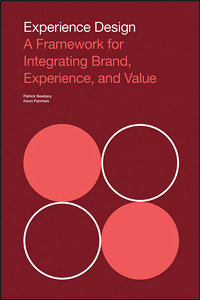
Experience Design
Photos: Wiley, Patrick Newbery, Kevin Farnham
In today’s business environment, it is necessary to support a brand through the product or service offerings across the entire lifeline of the customer relationship rather than only on the day he or she make a purchase. So say Patrick Newbery and Kevin Farnham who believe customers businesses should develop an “…understanding of how to look at opportunities, issues, strategies and tactics.” Achieving that, they argue, requires business managers and designers to collaborate and shift the way they approach their products.
“Apple’s reinvention of itself changed the world in many ways. The design of the end products and services is brilliant. But it wasn’t just how they were designed—it’s what Apple chose to design, and why, that mattered,” said Farnham, chief executive officer of Method. “Apple created value by redefining the experiences people could have with products they already wanted to use.”

Kevin Farnham, co-author, Experience Design
In Experience Design: A Framework for Integrating Brand, Experience and Value (Wiley, $32), a 232-page softcover book published in 2013, they explain their thinking. The book is divided into three sections, Context, Frameworks and Tools, and Moving Forward; and ten chapters: Thinking about Design, Thinking about Business, Thinking about Change, Thinking about Experience Design, Brand Frameworks and Tools, Product/Service Framework and Tools, Customer Journey Framework, Putting It Together, Getting Business to Act on Experience Design, and Working with Vendors.

Patrick Newbery, co-author, Experience Design
“Value drives relevance which drives engagement, which is the best way to drive revenue,” said Newbery, Method’s chief strategy officer. “The age of image as brand is closing. Trying to fix the experience at the 11th hour through brilliant design alone cannot create value that doesn’t exist.”
The authors highlight that only 25 percent of new product innovations ever reach commercial launch, and only 45 percent of those meet profit goals, resulting in an 11 percent success rate.
They’re of the opinion that experience design provides business a reason to invite design to the table earlier than is common while making it possible for executives to understand how design can help solve problems that expand past look and feel. They suggest a company and its products benefit when they invite design contributors to the conversation early on in the development process.
The authors intended audience is primarily business folks who engage design or who manage key aspects of the customer experience and need to understand how to use design more effectively to meet business goals. Their secondary audience is “design professionals who are multi-disciplinary and looking to develop their skills and understanding about how to help clients understand how to plan for and evaluate design.”
Farnham is responsible for company strategy, global recruiting, and business development at his company. In the last twenty years, according to his bio, he has worked directly with business leaders from companies Apple, BBC, Microsoft, MoMA, Nike, Google, and TED Conferences. Newbery, a resident of Berkeley, relies on his experience with strategy, brand, innovation, and design to develop the tools and frameworks that his company uses to shape client engagements.

Click to buy Experience Design
Comments:
Filed Under: Book
Posted by Elena del Valle on February 7, 2014

Peruvian Power Foods
Photos: Health Communications, Inc.
Manuel Villacorta, MS, RD, CSSD dedicated two years to researching particularly nutritious foods, traveling to his native Peru to connect with chefs, farmers, food bloggers, fishermen, and people in general about that country’s indigenous foods. As part from his journey of discovery the dietician with 16 years of experience created 100 recipes and took 2,000 photos many of which are featured in Peruvian Power Foods: 18 Superfoods, 101 Recipes, and Anti-aging Secrets from the Amazon to the Andes (Health Communications, Inc. $18.95), a 310-page paperback book he wrote with the help of coauthor Jamie Shaw, a writer, branding specialist and recipe creator. The recipe examples include breakfast granola with lucuma, white bean hummus with sacha inchi, pichuberry muffins, maca shake, and truffles with cacao and camu camu.
“The reception has been great. Peruvian cuisine is a hot topic at the moment,” Villacorta said by email in response to a question about the public acceptance to his new book published October 2013. “Chefs are heralding the cuisine with the enthusiasm they once reserved for France. Peruvian restaurants are popping up in major cities everywhere. On his Parts Unknown program, Anthony Bourdain dubbed Peru’s cuisine one of the most underrated in the world. Clearly, something was happening in my home country. And while it’s partially due to the innovative preparations and exciting cross-cultural dishes being developed, Peru is also home to thousands of foods found nowhere else on the planet, many of which are staggering in their content of potent nutrients. As a native Peruvian, I felt there was no better time than the present to share my knowledge about the foods that originate from the region. And as a registered dietitian, I was interested in the health properties of these foods. This book helped me marry the two, health and cooking.”

Manuel Villacorta, MS, author, Peruvian Power Foods
The book highlights 18 foods believed to be particularly high in nutrient value. They are pichuberry, maca, cacao, kiwicha, avocado, aji, camu camu, purple corn, artichokes, sacha inchi, lucuma, beans, purple potatoes, cilantro, papaya, yacon, quinoa, and sweet potatoes. Each food section features nutritional aspects, culinary uses, and recipes.
“Yes. Moreover, I’m especially finding the Latino population to be very receptive, and have been asked on many occasions, if the book will be translated into Spanish,” the nutritionist said when asked about the popularity of the book among immigrant families.
While some like artichokes, cilantro, sweet potatoes, beans and avocado are easy to find many others are not prevalent in supermarkets. Fresh pichuberries, for example, seem particularly challenging to find. In Appendix B and by email in response to a question about how to purchase the ingredients for the recipes he said: “Latino markets and/or regular supermarkets like Whole Foods, Trader Joe’s, Safeway, and Vons. Brands used in the book were Sacha Vida, Navitas, Barry Farm, and Bobs Red Mill.”
Villacorta is also author of Eating Free: The Carb-Friendly Way to Lose Inches, Embrace Your Hunger, and Keep the Weight off for Good. He served as a national media spokesperson for the Academy of Nutrition and Dietetics. He is a health blog contributor to The Huffington Post, an on-air contributor to Univision, and a health and lifestyle contributor for Fox News Latino. He owns a San Francisco-based private practice.

Click to buy Peruvian Power Foods
Comments:
Filed Under: Books
Posted by Elena del Valle on February 5, 2014
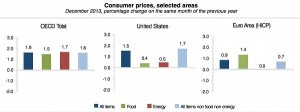
Consumer prices, selected areas December 2013, percentage change on the same month of the previous year – click to enlarge
Image: Organization for Economic Co-operation and Development (OECD)
Annual inflation rose in the United States to 1.5 percent up from 1.2 percent, according to Organization for Economic Co-operation and Development (OECD) figures released this week. In Canada, the change was 1.2 percent in December 2013 up from 0.9 percent in November 2013 while in Germany it went to 1.4 percent up from 1.3 percent; and Japan it went to 1.6 percent up from 1.5 percent. It remained at 0.7 percent in France and Italy and dropped in the United Kingdom to 2 percent down from 2.1 percent. The overall Euro area annual inflation increased to 0.9 percent in December, compared with 0.8 percent in November.
In the OECD area, consumer prices went up by 1.6 percent in the year to December 2013, compared with 1.5 percent in the year to November 2013. This minor increase in the annual rate of inflation was driven for the most part by energy prices which increased by 1.7 percent in the year to December, compared with stable prices in November. The annual price inflation of food was steady at 1.5 percent in December. The OECD annual inflation rate excluding food and energy was also stable at 1.6 percent in December.
The OECD tracks changes in developed countries and provides a forum for member governments to compare policy experiences, search for answers to common problems, identify good practices and coordinate domestic and international policies.
Posted by Elena del Valle on January 29, 2014
By Ivette M. Achong
Vice president
Connect360 MultiMedia

Ivette M. Achong, vice president, Connect360 MultiMedia
Photo: Connect360 MultiMedia
It’s no secret that the U.S. Hispanic community has become one of the most powerful marketing segments in the country, both in terms of population size and purchasing power. According to the U.S. Census Bureau, the country’s Hispanic population grew to 53 million as of July 1, 2012, making people of Hispanic origin the nation’s largest ethnic or racial minority. As of 2060, the Census Bureau is projecting that the U.S. Hispanic population will rise to 128.8 million, constituting 31 percent of the nation’s population by that date. Marketing research also indicates that Hispanic purchasing power currently stands at $1 trillion with continued growth in the years ahead.
Click to read the entire article The Path to a Successful Hispanic PR Campaign
Posted by Elena del Valle on January 22, 2014
By Chris McGinnis, business travel expert
Amy Graff, family travel expert
Best Western

Amy Graff, family travel expert, Best Western
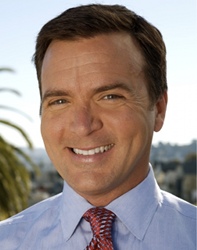
Chris McGinnis, business travel expert, Best Western
Photos: Allison+Partners
2013 has come and gone but travel remains strong as airlines and hotels are finally seeing a solid and consistent turnaround in the number of bookings. It’s no surprise that in 2014, we can expect a continuous flow as it’s expected to be the busiest travel season yet, following the recession.
As cold weather settles in for the winter, and the stress of the holidays begins to take its toll, travelers are looking ahead to 2014 and are already planning their next vacation. Graff offers her top picks for 2014 travel destinations and her predictions for family and leisure travel in 2014.
Click to read the entire Travel in the New Year 2014 Predictions
Posted by Elena del Valle on January 13, 2014

Deborah Koons Garcia, director, Symphony of the Soil
Photo: Lily Films
A podcast interview with Deborah Koons Garcia, director, Symphony of the Soil (see With video Documentary highlights importance of healthy soil) is available in the Podcast Section of Hispanic Marketing & Public Relations, HispanicMPR.com. During the podcast, she discusses her film with Elena del Valle, host of the HispanicMPR.com podcast.
At Lily Films, her Mill Valley, California production company, Deborah has made fiction, educational and documentary films. For the last fifteen years, she has focused primarily on films about soil, agriculture and the food system.
Her film, The Future of Food, premiered at Film Forum in New York City. It continues to play widely around the world in theaters and at film, food and farming festivals and conferences and at thousands of community-organized screenings. She has personally taken her film to innovative venues such as Google headquarters, Burning Man arts festival in the desert of Nevada, and shown it to inmates in the gardening program at San Quentin prison.
Symphony of the Soil premiered at the Smithsonian in the spring of 2012 and has been playing at film festivals, conferences, theaters and community screening all around the world since then. In October 2013, The New York Times gave the film a very positive Critic’s Choice review.
She was recently awarded the John de Graaf Environmental Filmmaking Award at the Wild and Scenic Film Festival for her body of films on soil, agriculture and sustainability.
To listen to the interview, scroll down until you see “Podcast” on the right hand side, then select “HMPR Deborah Koons Garcia” and click on the play button below or download the MP3 file to your iPod or MP3 player to listen on the go, in your car or at home. To download it, click on the arrow of the recording you wish to copy and save it to disk. The podcast will remain listed in the January 2014 section of the podcast archive.
Posted by Elena del Valle on January 8, 2014
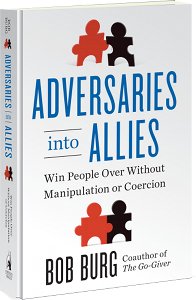
Adversaries into Allies
Photos: Bob Burg
Bob Burg believes that being successful in life and in business is the result of having technical and people skills. Ninety percent of the success comes from people skills and only ten percent from technical skills, according to him. He says that there are many highly talented people in the world who only achieve average results because they lack good people skills.
In Adversaries into Allies: Win People Over Without Manipulation or Coercion (Portfolio, $26.95), published in 2013, Burg explores the path to influence by converting adversaries into partners. It’s his opinion that persuasion need not be about winners and losers. He proposes an approach that results in mutual benefit rather than one that leaves the other person feeling taken advantage of which in turn might produce resistance and a negative attitude.
The 250-page hardcover book is divided into 76 chapters and six main sections: The Five Principles of Ultimate Influence, Control Your Own Emotions, Understand the Clash of Belief Systems, Acknowledge Their Ego, Set the Proper Frame, Communicate with Tact and Empathy, and The Character of Ultimate Influencers.
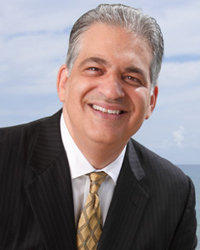
Bob Burg, author, Adversaries into Allies
He defines Ultimate Influence as the ability to get the results you want from others while making them feel genuinely good about themselves, the process, and about you. One of the ways to do that, he says, is for people to control their own emotions. Such control allows them to help their adversaries be open to the ideas they propose. He stresses that to avoid confusion it’s important to understand that we all follow an unconscious set of beliefs based on experiences and ideas which vary from one person to another.
Helping people feel good about themselves helps the influencer make an ally, according to Burg. Approaching a conflict from a position of benevolence, resolution, and helpfulness increases the likelihood that an adversary will follow the influercer’s lead; and communicating with tact and empathy at the right time can go a long way to win someone over, he says.
Burg is coauthor of The Go-Giver, Go Givers Sell More, and It’s Not About You, and the author of Endless Referrals. According to promotional materials, The Go-Giver was a BusinessWeek and The Wall Street Journal bestseller and has been translated into twenty languages. Together, his books have sold more than a million copies. A speaker, Burg presents to corporations and associations internationally, including Fortune 500 companies, franchises and direct sales organizations.

Click to buy Adversaries into Allies
Comments:
Filed Under: Books
Posted by Elena del Valle on January 1, 2014

Wishing you a New Year filled with health, joy and prosperity.
Posted by Elena del Valle on December 20, 2013

Wealthy by Design
Photo: Kimberly Foss
Kimberly Foss, CFP, CPWA, rose from a home with “financially challenged parents” to become the president and founder of Empyrion Wealth Management, which according to promotional materials, was named one of the nation’s top wealth managers by Bloomberg’s Wealth Manager Magazine. In Wealthy by Design (Greenleaf Book Group Press ebook), published June 2013, she shares some of her life story and wealth management ideas. She assumes readers will rely on a financial planner who will work with them based on their goals, risk taking preferences, equity and age.
She explains that there are two primary types of financial advising services, consultative and transactional. The former focus on client goals and needs and charge based on the number of assets they manage for a given client while the latter recommend products for which they earn commissions. In Appendix A, she provides readers questions to ask a prospective adviser. In Appendix B, she offers six allocation strategies for portfolios. In the ebook edition, it was challenging to read the graphics as displayed on the tablet reader.
In her book, she outlines the importance of understanding personal financial drivers before making long term investment decisions. She strives to demonstrate to readers how following five foundational principles of investing can lead to wealth management based on individual goals and circumstances. The principals are: Goal Setting, Planning, Commitment, Assessment, and Flexibility. The book is divided into an Introduction, a chapter each for the principles, and a Conclusion as well as two appendices. She relies on case studies and anecdotes to illustrate her points. For example, she describes a risk averse client for whom she organized, thanks to her banking relationships, a 15-year CD.
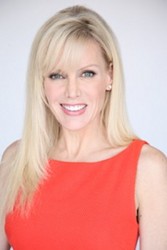
Kimberly Foss, author, Wealthy by Design
She touts the importance of focusing on the best interests of clients, the relationship between asset allocation strategy and the success of a portfolio, and portfolio diversification. An investor’s approach to building wealth, she says in the Conclusion, should be considered with care, planned, reviewed and never random.
Foss has 26 years of financial services experience. She is a member of the Investment Management Consultants Association.

Click to buy Wealthy by Design
Comments:
Filed Under: Books




























